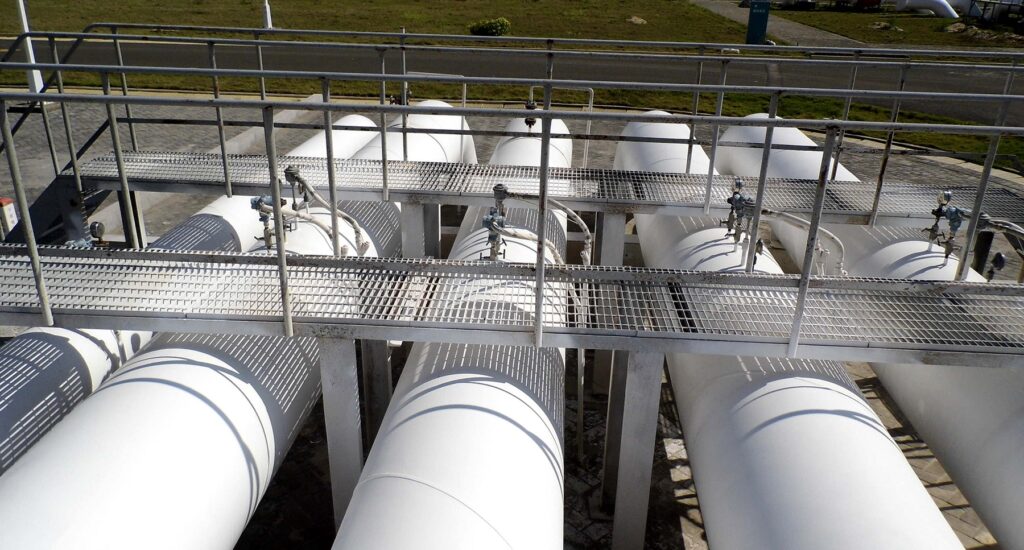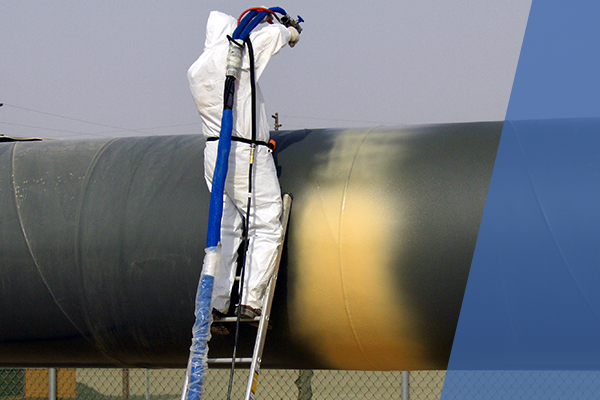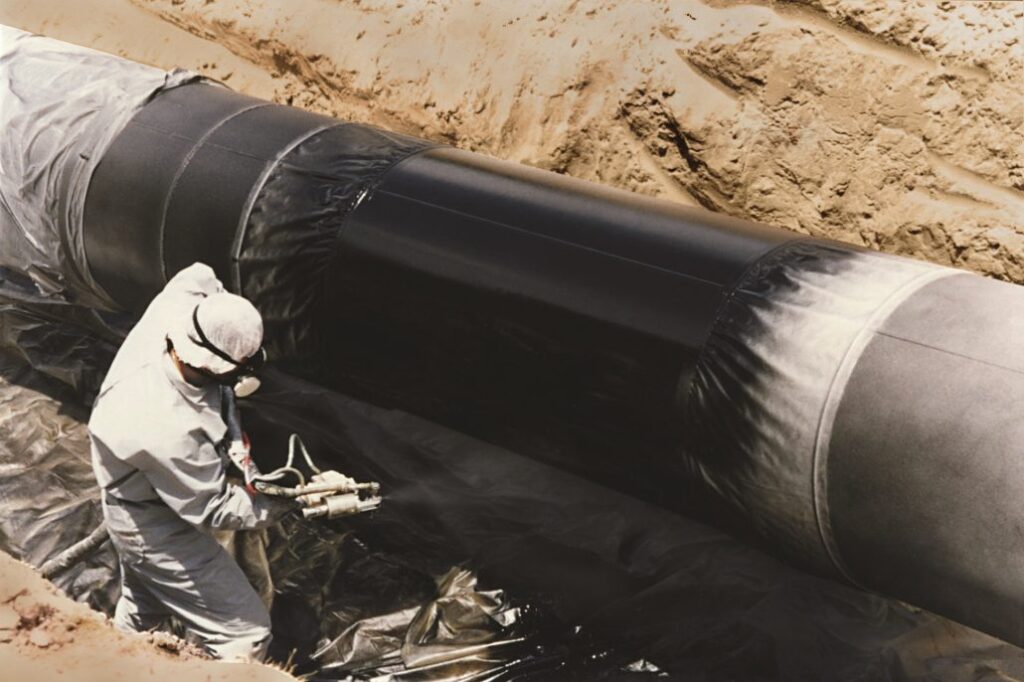THE GO TO OIL PIPELINE COATING
olyurea is quickly becoming the go-to coating for oil pipelines, as it provides superior protection against corrosion compared to traditional coatings. It’s a two-component material that is sprayed on the surface of a pipe and cures into a seamless barrier that not only prevents rust and other elements from corroding the pipeline, but also helps maintain its structural integrity.
The use of polyurea in oil pipeline coatings has been steadily increasing over the past few years due to its many advantages over other types of pipeline coatings. Its superior resistance to corrosion makes it ideal for protecting pipelines from the harsh environmental conditions they are exposed to every day. Polyurea can stand up to high temperatures, high pressure, harsh chemicals, and even ultraviolet light without breaking down or losing its effectiveness. This makes it ideal for use in offshore drilling operations where there are often nearby sources of water and other fluids that can corrode unprotected pipes.

WHAT IS POLYUREA?
Polyurea is a coating material used in various industrial applications for decades, including oil and gas pipeline coatings. It is a thermosetting resin that forms when two components are mixed and then cured. Polyurea coatings have excellent physical properties such as flexibility, high tensile strength, chemical resistance, abrasion resistance, tear resistance and low moisture absorption. These properties make polyurea well-suited for use in offshore or subsea oil and gas pipelines that must withstand extreme environmental conditions.
Polyurea has many advantages over traditional pipeline coatings such as epoxy or polyurethane. One of the most important advantages is its fast curing time; when applied to a surface, polyurea can harden within minutes rather than hours or days as with other materials. This makes it an ideal choice for quick repairs or installation in remote sites as well as emergencies. Polyurea is highly resistant to corrosion, which allows it to perform extremely well in wet environments such as water treatment plants and marine applications.
In terms of its composition, polyurea consists of two components that react with each other during the application process. The first component comprises isocyanates while the second contains active hydrogen compounds such as amines or alcohols. When these two components come into contact with each other, they form a polymer chain that binds them together and creates the resulting coating material. For this process to occur properly, the correct ratio of Isocyanate to Hydrogen Compound must be maintained during the mixing process; if this ratio is not met, then the resulting product will be weak or brittle and easily damaged by environmental factors such as heat and cold temperatures or UV radiation exposure.
When applied correctly, polyurea coatings can protect from abrasive elements such as sand particles and saltwater spray found in offshore environments while also providing insulation against thermal shock from temperature changes due to seasonal weather variations. Polyurea can also serve as a vapor barrier keeping corrosive gases out while allowing moisture trapped inside surfaces to escape without causing damage.
Due to its impressive performance characteristics and versatility across multiple industries, including oil refinery operations and water treatment systems, polyurea is becoming increasingly popular among engineers for any number of projects requiring top-quality protection from harsh environmental conditions or demanding mechanical stressors like vibration or movement caused by waves or tides at sea level installations. It’s important, however, that proper application techniques are followed strictly during installation; otherwise, premature failure may result due to improper mixing ratios or improper curing times, so experienced professionals should always be consulted prior to beginning work on any project involving this material to maximize performance and longevity results upon completion.
BENEFITS OF USING POLYUREA FOR PIPELINE COATING

A major benefit of using polyurea as an oil pipeline coating is its ability to be applied quickly and easily. Traditional coatings can take days or weeks to cure properly, whereas polyurea can be applied in just minutes with no curing time required. This allows for significantly faster completion times on projects involving large pipelines and reduces installation costs significantly compared to other types of coatings. It also helps reduce labor costs since fewer workers are needed to install it than with other coatings, which can sometimes require large teams of workers working long hours over several days or weeks.
In addition to its superior resistance to corrosion and ease of application, polyurea has excellent adhesion properties that make it capable of forming a strong bond with various surfaces, including steel and concrete. This ensures that any cracks or weak spots in the pipe wall are sealed securely, preventing any further damage from occurring inside the pipe wall over time due to leaks or corrosion. Its flexibility also allows it to expand and contract with changes in temperature without cracking or failing like some traditional coatings would do under similar conditions.
Polyurea also offers excellent insulation properties that help prevent heat loss during transport, which helps reduce energy costs associated with shipping crude oil through long distances via pipelines and reduces heat loss during refining processes at refineries located near production sites. In addition, polyurea does not contain any volatile organic compounds (VOCs) so there is no need for special permitting related VOC emissions when applying the coating onsite at production facilities – this benefits both environmental safety and cost savings associated with avoiding permit fees or additional fines imposed by regulatory bodies related VOC emissions near production sites.
Finally, one last benefit of polyurea is its low maintenance requirements throughout a pipeline’s lifespan due mostly to its durability and resistance against harsh elements such as UV rays, temperatures extremes, solvents, salt water exposure etc… All these factors combined make polyurea one of most effective yet cost-efficient solutions available today when it comes selecting an appropriate coating option for oil pipelines used in transporting crude oil around the world safely and efficiently while ensuring regulatory compliance necessary ensure safety standards followed around workplace environments near production sites where employees come into contact with hazardous materials involved in drilling operations worldwide each day without fear of health risks associated possible exposure aforementioned elements involved drilling process itself otherwise might result costly lawsuits company itself should an unfortunate incident occur premises work . With all these advantages taken into consideration , it’s no wonder why more companies are opting use polyurea as their choice coating solution when constructing new oil pipelines looking to extend life existing ones currently service .

